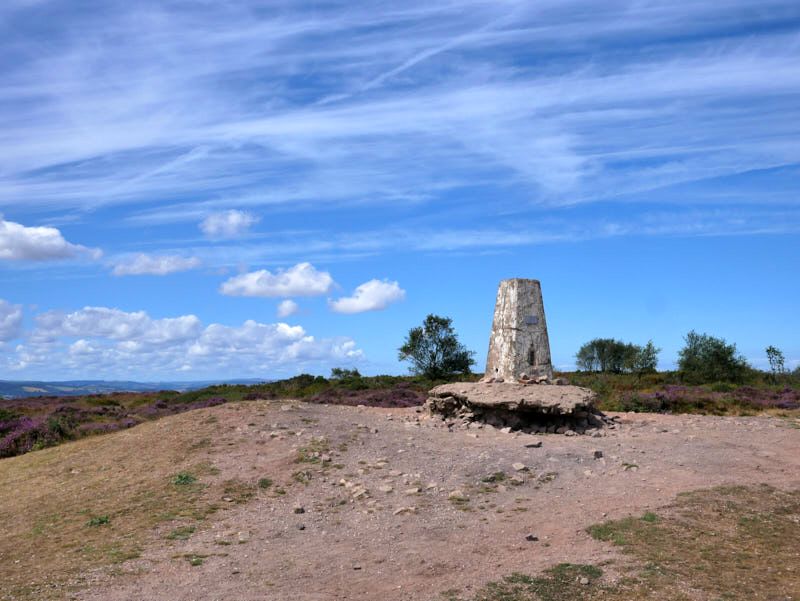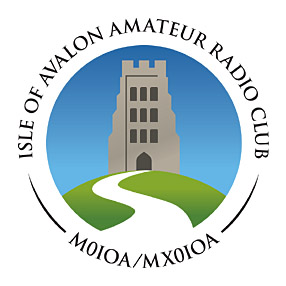Wills Neck SOTA activation
I activated Wills Neck on the Quantock Hills near Exmoor today, using a handheld Yaesu FT3DE and a flowerpot antenna. This was much less of a battle than Beacon Batch because the activation was in the middle of the day, and Wills Neck doesn’t have commercial transmitters on the summit.

getting chasers - a numbers game
It was easier this time than Beacon Batch because though it was a weekday morning it is in the school summer holidays which seems to get more SOTA activity.
After struggling on that summit I read the RSGB book SOTA explained, which helped me raise the odds. Apparently SOTA activators tend to be early birds, which I am not - although I got out by 8am I managed to forget to take lunch and any water, so had to make do with the three cups of coffee I had before going out. This would have been unwise for a high summit, but was OK to clear the hill by 2pm.
That early-bird tendency explains the dearth of listeners in the evening on Beacon Batch, who have probably switched on the telly by then, as the chasers need to match their listening to the morning tendency of activators.
Operating location
I started out from the Lydeard Hill car park to the south east this time, which is a slightly gentler ascent that the Triscombe Stone car park to the north-west. The road to Lydeard Hill runs along a single track road from North Petherton along the ridgeline that becomes Wills Neck, whereas Triscombe Stone can be approached via the A39, turning off just before Nether Stowey. Lydeard Hill lets me bypass Bridgwater using the M5 for one junction, Triscombe Stone means I have to go through Bridgwater but the stretch after it is a main road. Both mean a start from about the 320m mark, ascending to 384, so not too much fo a stretch.

I used a tumulus a couple of hundred yards away from the trig point, which lets other folk bag the trig point and take selfies without bothering them. It is within the 375m contour, easily within the permitted 25m from the 386m point height of the top of the trig, which defines a 365m contour activation zone. I used a homebrew SOTA mic with a Rycote faux fur windshield, which helped intelligibility in the wind, and headphones. A tree supported the antenna poles, it so happened that the tumulus screened the operating point from the view of the trig point so people’s selfies were unpolluted. It is a good operating location, and I will bear it in mind as a chase and indeed decent RF takeoff more generally.

Summit to summit (s2s)
To improve my odds I had chosen the day to coincide with GW0WPO/P who was activating a few SOTA summits, to try and pitch for a summit-to-summit. I caught up with him on GW/SW-034, and again on GW/SW-027 from home. I managed another s2s with GW0AXY/P on GW/SW-037 Craig Yr Allt earlier in the day, and my first contact of the day was Ben 2E0VOO/P activating a HEMA summit near Exeter. That was G/HDC-022 Woodbury Common, so I got a HEMA chase and a SOTA to HEMA s2s for the win. True to form, HEMA activators are also early birds, Ben was first in the log at 10:22 UTC. I missed GW0WPO/P who was alerted at 10:30 and spotted then - on 80m

because he was on HF, but caught up with him an hour later on 145.450 at 11:35 UTC.
Antenna used
I used a flowerpot antenna made from two sections of Vango fibreglass tent repair poles for structure to support the coax, and fitted a connector to the halfway point where the dipole top comes out of the cable, so the antenna breaks down to 1m sections. Four more sections let me loft this 4m in the air, however I am a SOTA (and camping in general) tyro so I don’t do guying, which is why I need a low tree to support the flimsy construction. That’s all very well on 1 pointer summits below the treeline with a broad activation area so you have a chance to use trees, but it won’t help me on 8 point summits or rocky sites. On the upside the antenna is lightweight and swift to rig and strike, which was useful to catch GW0WPO/P on GW/SW-034. This should have been an easy win 40 miles across the Bristol Channel, but the FT3DE with a RH-771 on board could hear him and another QSO, but not reach him. I was checking out the trig point itself, and had to hurry back to the tumulus and tree to rig the antenna to make the QSO. A photography fail means I have no pic of the antenna in the tree.
Amplifier
I had a rebuilt 1980s amplifier to boost the power to 25W from the FT3DE’s nominal 5W1, taking a tip from Catterblog that if all you have is 2m FM then you sometimes need a bit more power to match home base stations.
Testing the amp with a few of my contacts it wasn’t necessary from this summit. I did notice that I was having an easier time than Ken GW0AXY/P who was using a Woxun handheld with rubber duck antenna from the summit of Craig yr Allt, although he was closer to the South Wales summits he was pitching for, and on a better takeoff, but in this case the difference was probably the antenna. Using an amplifier makes it easy to switch between QRO and QRP as the T/R relay bypasses the amplifier when it’s off. Mine is a ELH230 amplifier like this one but without the RF preamp which is probably fine because 30 years of radio development has probably made front-ends less noisy than back in the day, and SOTA operation often has to contend with excess incoming signals from commercial sites. It’s not a dedicated FM amplifier so it will lack efficiency relative to an FM amplifier, conversely I could use SSB with it. It cost me £45 plus a bit of work to clean it up, insulating tape used rather than heatshrink internally is never a good sign.
Operating position. Zoom out for stations worked locations.
Logging

I used the feature of the FT3DE to record outgoing and incoming audio onto the SD card as a 16-bit 16kHz sampled WAV signal. The start of the recording is timestamped and it records the file until the recording is stopped or the rig is turned off. This saved me having to paper log, but I end up with a long stream-of-consciousness recording. It holds most of the information, but you have to listen to the QSO to pick up the frequency we QSYed to from the calling channel. What I had expected to get was a string of files with each QSO, but there’s no real way for the rig to know when one QSO finishes and another starts.
The recording of received audio is overrecorded to the point of clipping and DC off-centred. However, it is intelligible. I don’t know if people generally push their modulation levels, because not everyone was so high - G4OEC on a base station rig was fine as was one other fixed station.
What I learned
- The flowerpot antenna worked well, and poking it up through a tree seems to be fine. It gets out better than the FT3DE with a Nagoya RH771, as I found out with GW0WPO/P
- The amplifier worked well, switching it on and off means it is available but not necessary, only consuming power when in use.
- Audio logging has promise, but probably wants to be done more intelligently. Unfortunately it’s not easy to switch it on and off with the FT3DE, which involves diddling with the touch screen. I hate touch screens. It defaults to off on power cycling the rig, making turning it off simpler.
- I find it hard to achieve a consistent voice level. At home I achieve this using a MFJ-299 which performs the function of a VOGAD as used in the Clansman radios, for use by untrained Army personnel. The right way to fix this is to learn how to do it properly, but doing that in the field while trying to keep a bunch of other things in mind is easier said than done. Inconsistent audio level is particularly bad for a s2s or mobile contact where the other party is dealing with varying ambient noise in the field
- I could use a CQ parrot, which could also double up as a VOGAD to address the inconsistent audio level as they usually have AGC to optimise the SNR of the recording. The Chinese make kits offering 10 seconds of recording which is about right for a CQ. It would save me getting so thirsty and help on more populated summits - we are inured to people on their mobile phones so a QSO would be OK, but a repetitive CQ SOTA voiced every five minutes could get tiresome after a while.
- Conversely, the use of a lavalier windshield on my homebrew SOTA mic improves my outgoing audio relative to other summit operators, because I suffered much less wind blast. This probably compensates a bit for the inconsistent audio level. As a chaser I have really struggled to understand some SOTA activators on windy summits.
- I could do with speaking faster and thinking faster, compared to seasoned operators my delivery was quite slow at times. Perhaps this is a practice thing ;)
- I liked GW0WPO/P’s approach of calling “CQ CQ SOTA this is GW0WPO/P listening on 145.450 and calling CQ” on the calling channel, because it tells me where to go to contact him right from the get-go. Presumably he has a dual channel Rx on 145.500 and 145.450 and flips from one side to the other as appropriate. It saves some of the faff and time involved in QSYing to the other channel.
- I was not spotted. Sotawatch barfed on my username and password and refused to take the spot. However, luck and decent RF performance trumped self-spotting in this particular location, but that is why the only known SOTA chasers were the other S2S stations GW0WPO/P and GW0AXY/P

-
in practice less from the internal 7.4V battery, 5W is specified at 13.8V external power, and Yaesu are cagey about specifying the TX power off batteries, which is how most people use a handheld radio. ↩
